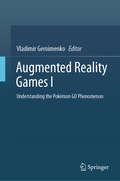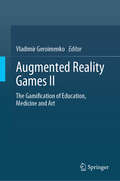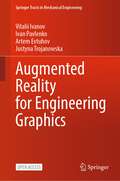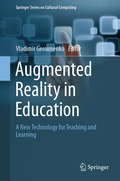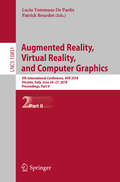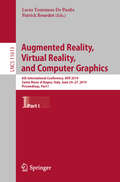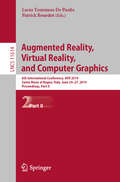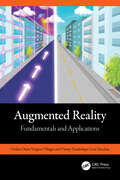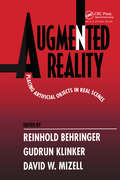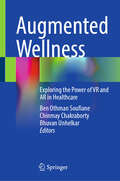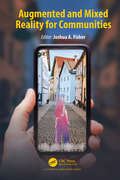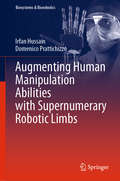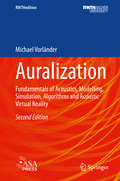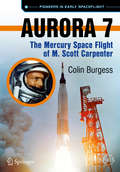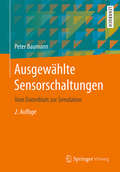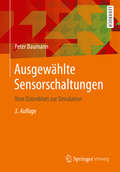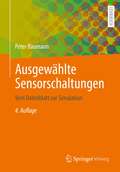- Table View
- List View
Augmented Reality Games I: Understanding the Pokémon GO Phenomenon
by Vladimir GeroimenkoThis is the first of two comprehensive volumes that provide a thorough and multi-faceted research into the emerging field of augmented reality games and consider a wide range of its major issues. These first ever research monographs on augmented reality games have been written by a team of 70 leading researchers, practitioners and artists from 20 countries. In Volume I, the phenomenon of the Pokémon GO game is analysed in theoretical, cultural and conceptual contexts, with emphasis on its nature and the educational use of the game in children and adolescents. Game transfer phenomena, motives for playing Pokémon GO, players’ experiences and memorable moments, social interaction, long-term engagement, health implications and many other issues raised by the Pokémon GO game are systematically examined and discussed. Augmented Reality Games I is essential reading not only for researchers, practitioners, game developers and artists, but also for students (graduates and undergraduates) and all those interested in the rapidly developing area of augmented reality games.
Augmented Reality Games II: The Gamification of Education, Medicine and Art
by Vladimir GeroimenkoThis is the second of two comprehensive volumes that provide a thorough and multi-faceted research into the emerging field of augmented reality games and consider a wide range of its major issues. These first ever research monographs on augmented reality games have been written by a team of 70 leading researchers, practitioners and artists from 20 countries. Volume II explores the most important and challenging issues that have been raised by the use of the Augmented Reality approach and technology in the gamification of education, healthcare, medicine and art. The volume deals with a systematic analysis of educational augmented reality games, their use for health promotion in old age and for improving people’s well-being, the gamification of augmented reality art and immersive reading experiences, among other topics. Augmented Reality Games II is essential reading not only for researchers, practitioners, game developers and artists, but also for students (graduates and undergraduates) and all those interested in the rapidly developing area of augmented reality games.
Augmented Reality Games II: The Gamification of Education, Medicine and Art
by Vladimir GeroimenkoThis is the second edition of the first ever research monograph that explores the exciting field of augmented reality games and their enabling technologies. The new edition has been thoroughly revised and updated, with 6 new chapters included. As well as investigating augmented reality games in education, the book covers the gamification of medicine, healthcare, and art. It has been written by a team of 43 researchers, practitioners, and artists from 12 countries, pioneering in developing and researching the new type of computer games.This book deals with a systematic analysis of educational augmented reality games, the gamification of elementary and secondary education, teachers’ novel key skills and new teaching methods in the classroom, creating immersive and playful reading experiences, augmented reality games for health promotion in old age and for transforming dental and physical education and practice, the gamification of augmented reality art, pervasive games, and gaming in public spaces, among other topics.Intended as a starting point for exploring this new fascinating area of research and game development, it will be essential reading not only for researchers, practitioners, game developers, and artists, but also for students (graduates and undergraduates) and all those interested in the rapidly developing area of augmented reality games.
Augmented Reality for Engineering Graphics (Springer Tracts in Mechanical Engineering)
by Vitalii Ivanov Justyna Trojanowska Ivan Pavlenko Artem EvtuhovThis open access book offers a timely snapshot of Augmented Reality (AR) technology, with an emphasis on its application within the mechanical and manufacturing engineering domains, for both educational and industrial purposes. Reporting on the experience of the authors, the book introduces readers to the principles of product design, with an emphasis on modern strategies and approaches for user-centered design, creativity, and design for manufacturing and sustainability. It guides to the application augmented reality and visualization techniques in the design process. In turn, it describes an AR mobile application developed by the authors to transform 2D drawings into dynamic 3D objects. The book also includes exercises. All in all, this book offers a practice-oriented guide to Augmented Reality applications in mechanical engineering and education, addressing advanced undergraduate students, lecturers, and professionals in the engineering field. This is an open access book.
Augmented Reality in Education: A New Technology for Teaching and Learning (Springer Series on Cultural Computing)
by Vladimir GeroimenkoThis is the first comprehensive research monograph devoted to the use of augmented reality in education. It is written by a team of 58 world-leading researchers, practitioners and artists from 15 countries, pioneering in employing augmented reality as a new teaching and learning technology and tool. The authors explore the state of the art in educational augmented reality and its usage in a large variety of particular areas, such as medical education and training, English language education, chemistry learning, environmental and special education, dental training, mining engineering teaching, historical and fine art education. Augmented Reality in Education: A New Technology for Teaching and Learning is essential reading not only for educators of all types and levels, educational researchers and technology developers, but also for students (both graduates and undergraduates) and anyone who is interested in the educational use of emerging augmented reality technology.
Augmented Reality, Virtual Reality, and Computer Graphics: 5th International Conference, AVR 2018, Otranto, Italy, June 24–27, 2018, Proceedings, Part I (Lecture Notes in Computer Science #10850)
by Lucio Tommaso De Paolis Patrick BourdotThe 2-volume set LNCS 10850 and 10851 constitutes the refereed proceedings of the 5th International Conference on Augmented Reality, Virtual Reality, and Computer Graphics, AVR 2018, held in Otranto, Italy, in June 2018. The 67 full papers and 26 short papers presented were carefully reviewed and selected from numerous submissions. The papers are organized in the following topical sections: virtual reality; augmented and mixed reality; computer graphics; human-computer interaction; applications of VR/AR in medicine; and applications of VR/AR in cultural heritage; and applications of VR/AR in industry.
Augmented Reality, Virtual Reality, and Computer Graphics: 5th International Conference, AVR 2018, Otranto, Italy, June 24–27, 2018, Proceedings, Part II (Lecture Notes in Computer Science #10851)
by Lucio Tommaso De Paolis Patrick BourdotThe 2-volume set LNCS 10850 and 10851 constitutes the refereed proceedings of the 5th International Conference on Augmented Reality, Virtual Reality, and Computer Graphics, AVR 2018, held in Otranto, Italy, in June 2018. The 67 full papers and 26 short papers presented were carefully reviewed and selected from numerous submissions. The papers are organized in the following topical sections: virtual reality; augmented and mixed reality; computer graphics; human-computer interaction; applications of VR/AR in medicine; and applications of VR/AR in cultural heritage; and applications of VR/AR in industry.
Augmented Reality, Virtual Reality, and Computer Graphics: 6th International Conference, AVR 2019, Santa Maria al Bagno, Italy, June 24–27, 2019, Proceedings, Part I (Lecture Notes in Computer Science #11613)
by Lucio Tommaso De Paolis Patrick BourdotThe 2-volume set LNCS 11613 and 11614 constitutes the refereed proceedings of the 6th International Conference on Augmented Reality, Virtual Reality, and Computer Graphics, AVR 2019, held in Santa Maria al Bagno, Italy, in June 2019.The 32 full papers and 35 short papers presented were carefully reviewed and selected from numerous submissions. The papers discuss key issues, approaches, ideas, open problems, innovative applications and trends in virtual and augmented reality, 3D visualization and computer graphics in the areas of medicine, cultural heritage, arts, education, entertainment, military and industrial applications. They are organized in the following topical sections: virtual reality; medicine; augmented reality; cultural heritage; education; and industry.
Augmented Reality, Virtual Reality, and Computer Graphics: 6th International Conference, AVR 2019, Santa Maria al Bagno, Italy, June 24–27, 2019, Proceedings, Part II (Lecture Notes in Computer Science #11614)
by Lucio Tommaso De Paolis Patrick BourdotThe 2-volume set LNCS 11613 and 11614 constitutes the refereed proceedings of the 6th International Conference on Augmented Reality, Virtual Reality, and Computer Graphics, AVR 2019, held in Santa Maria al Bagno, Italy, in June 2019.The 32 full papers and 35 short papers presented were carefully reviewed and selected from numerous submissions. The papers discuss key issues, approaches, ideas, open problems, innovative applications and trends in virtual and augmented reality, 3D visualization and computer graphics in the areas of medicine, cultural heritage, arts, education, entertainment, military and industrial applications. They are organized in the following topical sections: virtual reality; medicine; augmented reality; cultural heritage; education; and industry.
Augmented Reality: Fundamentals and Applications
by Osslan Osiris Vergara Villegas Vianey Guadalupe Cruz SánchezThis book focuses on augmented reality (AR) technology, which uses the real environment to superimpose virtual elements. Therefore, the reader can create applications that simulate scenarios that can be dangerous or expensive to generate in the real world. AR has proven helpful in education, marketing, and industrial scenarios. AR technology improves the user experience of various disciplines, incorporating virtual information that maximizes the experience and adds knowledge. This book intends students, researchers, and developers to have the possibility of finding the foundations on which AR technology rests.Our book intends that students, researchers, and developers: (i) learn the basics of AR; (ii) understand the technologies that support AR; (iii) know about AR applications that have been a watershed; (iv) gain an understanding of the critical elements needed to implement an AR application; (v) acquire skill in the step-by-step development of an AR application; (vi) learn how to use the instruments to evaluate an AR application; (vii) understand how to present the information about study cases; and (viii) gain knowledge about AR challenges and trends.
Augmented Reality: Placing Artificial Objects in Real Scenes
by Gudrun Klinker Reinhold Behringer David W. MizellThis book presents a variety of techniques that combine computer-generated images and other objects with real scenes, creating augmented reality. This work provides an excellent snapshot of the current state of augmented reality research and its latest applications to industry. Using computer vision, graphics, and signal processing, augmented reali
Augmented Wellness: Exploring the Power of VR and AR in Healthcare
by Bhuvan Unhelkar Chinmay Chakraborty Ben Othman SoufianeThis book is an essential resource that delves into the transformative potential of augmented reality (AR) and virtual reality (VR) within the healthcare industry. In a world where technology is continually reshaping the way we approach medical treatment, training, and education, this book provides a comprehensive exploration of how AR and VR technologies are becoming integral to the advancement of healthcare. It serves as a bridge between the rapidly evolving field of healthcare and the cutting-edge innovations in AR and VR, addressing the significant impact these technologies have on patient care, medical training, and the ethical considerations surrounding their use. The book has a broad audience, including healthcare professionals, students, and technology enthusiasts. It explores the practical applications of AR and VR in healthcare, highlighting their roles in patient education, pain management, telemedicine, and medical training. Additionally, the book delves into the ethical and regulatory considerations of integrating AR and VR into healthcare, sparking conversations around patient privacy and moral dilemmas. With real-world case studies and emerging technologies, "Augmented Wellness" provides readers with the knowledge to navigate the ever-changing landscape of augmented and virtual reality in healthcare. It is an invaluable resource for anyone seeking to understand, embrace, or innovate within this dynamic intersection of healthcare and technology. It ensures that healthcare transformation through AR and VR is beneficial and ethically responsible. This comprehensive book explores the vast and intricate universe of Virtual and Augmented Reality in healthcare. It delves into the multitude of ways in which these technologies are being harnessed todiagnose, treat, educate, and support patients. The aim is to provide an in-depth understanding of the present state and exciting potential future of VR and AR in the healthcare ecosystem. We have created a resource accessible to a broad audience, from healthcare professionals and technology enthusiasts to policymakers and students. The book offers a balanced blend of real-world case studies, expert insights, technical details, and practical applications, covering a wide range of topics, from using VR for pain management and physical therapy to AR's role in assisting surgeons during complex procedures.
Augmented and Mixed Reality for Communities
by Joshua A. FisherUsing mixed and augmented reality in communities is an emerging media practice that is reshaping how we interact with our cities and neighbors. From the politics of city hall to crosswalks and playgrounds, mixed and augmented reality will offer a diverse range of new ways to interact with our communities. In 2016, apps for augmented reality politics began to appear in app stores. Similarly, the blockbuster success of Pokémon Go illustrated how even forgotten street corners can become a magical space for play. In 2019, a court case in Milwaukee, Wisconsin, extended first amendment rights to augmented reality. For all the good that these emerging media provide, there will and have been consequences. Augmented and Mixed Reality for Communities will help students and practitioners navigate the ethical design and development of these kinds of experiences to transform their cities. As one of the first books of its kind, each chapter in the book prepares readers to contribute to the Augmented City. By providing insight into how these emerging media work, the book seeks to democratize the augmented and mixed reality space.Authors within this volume represent some of the leading scholars and practitioners working in the augmented and mixed reality space for civic media, cultural heritage, civic games, ethical design, and social justice. Readers will find practical insights for the design and development to create their own compelling experiences. Teachers will find that the text provides in-depth, critical analyses for thought-provoking classroom discussions.
Augmenting Crop Productivity in Stress Environment
by Azamal Husen Mohammad Israil Ansari Shamim Akhtar AnsariThe book inculcates a holistic approach to improve crop productivity and quality for ensuring food security and nutrition to all. This warrants to identify various stress conditions prevalent globally and tailor crop adaptability and productivity to the maximum accordingly, employing physio-molecular modern tools and techniques with judicious amalgamation with conventional crop husbandry. As a result, the book chapters encompass diverse environmental factors, internal physio-molecular processes and their modulations with a final goal of expanding area under cultivation by utilization of constraint terrains of poor site quality and augmenting sustainable crop productivity and quality on the face of rapidly changing climate. The book includes role of plant hormones, nano-sensors, nanomaterials etc. in stress tolerance responses, capturing recent advancement in the field of stress tolerance, enlarging scope of coverage by gleaning modern literature and providing glimpses of futuristic scenario of agriculture practices that can render ‘balance staple food rich in nutrition, vitamins and minerals’ to teeming billions of global human populations. Thus, the book provides a comprehensive overview of the role of stress environment and understanding stress physiology for developing stress tolerant crops. The book covers current knowledge and future prospects to achieve enhanced food security under stress environment of crops. The renowned contributors elegantly crafted each chapter, suited alike to both classroom texts for graduate students and reference material for researchers. The language and style are simple and lucid with liberal use of illustrations. This book should be on the shelf of university/ personal libraries for inquisitive students and enlightened researchers.
Augmenting Human Manipulation Abilities with Supernumerary Robotic Limbs (Biosystems & Biorobotics #26)
by Domenico Prattichizzo Irfan HussainThis book offers a timely report on an emerging topic in the field of wearable assistive technology: the design and development of robotic extra fingers. After a concise review of the state of the art and a description of earlier prototypes, it discusses the authors’ efforts to address issues such as portability and wearability of the devices, including strategies to reduce fatigue and to integrate the motion of the extra fingers with that of the human hand. The book also explores optimized control algorithms and the design of wearable sensorimotor interfaces, and presents a set of tests carried out on healthy subjects and chronic stroke patients. Merging concepts from robotics, biomechanics, human factors and control theory and offering an overview of supernumerary robotic fingers, including the challenges, this book will inspire researchers involved in the development of wearable robotic devices and interfaces based on the principles of wearability, safety, ergonomics and user comfort.
Augmenting Your Career: How to Win at Work In the Age of AI
by David ShrierEssential reading for anyone who wants to be relevant in the workforce of tomorrow.Drawing on more than a decade of research on artificial intelligence and human systems, David L. Shrier, a globally recognised futurist and innovation specialist, delivers fascinating insights and tips on how to win at work in the age of AI. Artificial intelligence is driving workforce disruption on a scale not seen since the Industrial Revolution. Automation was once associated with mass layoffs in heavy industry like auto and steel, but computers are getting smarter and are beginning to replace traditionally 'white collar' roles like law, consulting, banking and finance.Yet some curious findings are emerging from the world's leading research labs. The combined intellect of people and machines working in harmony is able to achieve outcomes that are better than either can accomplish alone. Properly tuned AI systems can even help harness the power of the collective intelligence of an entire organisation or community to predict future events. This isn't science fiction; this is science fact the author personally helped discover.What are these new hybrid AI+people systems? What can specialised AI systems do to help you succeed in your career? How can you work most effectively with these machines?Written by a practitioner who has worked with some of the largest companies in the world as well as some of the most innovative startups, Augmenting Your Career provides a rare window into a frontier area of computer science that will change everything about how you work and what your job will look like. Read this book and fast track your evolution to the knowledge worker of the future.
Augmenting Your Career: How to Win at Work In the Age of AI
by David ShrierEssential reading for anyone who wants to be relevant in the workforce of tomorrow.Drawing on more than a decade of research on artificial intelligence and human systems, David L. Shrier, a globally recognised futurist and innovation specialist, delivers fascinating insights and tips on how to win at work in the age of AI. Artificial intelligence is driving workforce disruption on a scale not seen since the Industrial Revolution. Automation was once associated with mass layoffs in heavy industry like auto and steel, but computers are getting smarter and are beginning to replace traditionally 'white collar' roles like law, consulting, banking and finance.Yet some curious findings are emerging from the world's leading research labs. The combined intellect of people and machines working in harmony is able to achieve outcomes that are better than either can accomplish alone. Properly tuned AI systems can even help harness the power of the collective intelligence of an entire organisation or community to predict future events. This isn't science fiction; this is science fact the author personally helped discover.What are these new hybrid AI+people systems? What can specialised AI systems do to help you succeed in your career? How can you work most effectively with these machines?Written by a practitioner who has worked with some of the largest companies in the world as well as some of the most innovative startups, Augmenting Your Career provides a rare window into a frontier area of computer science that will change everything about how you work and what your job will look like. Read this book and fast track your evolution to the knowledge worker of the future.
Augmenting Your Career: How to Win at Work In the Age of AI
by David ShrierEssential reading for anyone who wants to be relevant in the workforce of tomorrow.Drawing on more than a decade of research on artificial intelligence and human systems, David L. Shrier, a globally recognised futurist and innovation specialist, delivers fascinating insights and tips on how to win at work in the age of AI. Artificial intelligence is driving workforce disruption on a scale not seen since the Industrial Revolution. Automation was once associated with mass layoffs in heavy industry like auto and steel, but computers are getting smarter and are beginning to replace traditionally 'white collar' roles like law, consulting, banking and finance.Yet some curious findings are emerging from the world's leading research labs. The combined intellect of people and machines working in harmony is able to achieve outcomes that are better than either can accomplish alone. Properly tuned AI systems can even help harness the power of the collective intelligence of an entire organisation or community to predict future events. This isn't science fiction; this is science fact the author personally helped discover.What are these new hybrid AI+people systems? What can specialised AI systems do to help you succeed in your career? How can you work most effectively with these machines?Written by a practitioner who has worked with some of the largest companies in the world as well as some of the most innovative startups, Augmenting Your Career provides a rare window into a frontier area of computer science that will change everything about how you work and what your job will look like. Read this book and fast track your evolution to the knowledge worker of the future.
August Weismann
by Frederick B. ChurchillAugust Weismann's 1892 theory that inheritance is transmitted through eggs and sperm provided the biological mechanism for natural selection. In this full-length biography, Frederick Churchill situates Weismann in the swirling intellectual currents of his day and shows how his work paved the way for the modern synthesis of genetics and evolution.
Auralization: Fundamentals of Acoustics, Modelling, Simulation, Algorithms and Acoustic Virtual Reality (RWTHedition)
by Michael VorländerAuralization is the technique of creation and reproduction of sound on the basis of computer data. With this tool it is possible to predict the character of sound signals which are generated at the source and modified by reinforcement, propagation and transmission in systems such as rooms, buildings, vehicles or other technical devices. This book is organized as a comprehensive collection of the basics of sound and vibration, acoustic modelling, simulation, signal processing and audio reproduction. With some mathematical prerequisites, the readers will be able to follow the main strategy of auralization easily and work out their own implementations of auralization in various fields of application in architectural acoustics, acoustic engineering, sound design and virtual reality. For readers interested in basic research, the technique of auralization may be useful to create sound stimuli for specific investigations in linguistic, medical, neurological and psychological research, and in the field of human-machine interaction.
Aurora 7: The Mercury Space Flight of M. Scott Carpenter (Springer Praxis Books)
by Colin BurgessTO A NATION enthralled by the heroic exploits of the Mercury astronauts, the launch of Lt. Cmdr. Scott Carpenter on NASA's second orbital space flight was a renewed cause for pride, jubilation and celebration. Within hours, that excitement had given way to stunned disbelief and anxiety as shaken broadcasters began preparing the American public for the very real possibility that an American astronaut and his spacecraft may have been lost at sea. In fact, it had been a very close call. Completely out of fuel and forced to manually guide Aurora 7 through the frightening inferno of re-entry, Carpenter brought the Mercury spacecraft down to a safe splashdown in the ocean. In doing so, he controversially overshot the intended landing zone. Despite his efforts, Carpenter's performance on the MA-7 mission was later derided by powerful figures within NASA. He would never fly into space again. Taking temporary leave of NASA, Carpenter participated in the U. S. Navy's pioneering Sealab program. For a record 30 days he lived and worked aboard a pressurized habitat resting on the floor of the ocean, becoming the nation's first astronaut/aquanaut explorer. Following extensive research conducted by noted spaceflight historian Colin Burgess, the drama-filled flight of Aurora 7 is faithfully recounted in this engrossing book, along with the personal recollections of Scott Carpenter and those closest to the actual events.
Ausgewählte Sensorschaltungen
by Peter BaumannIn diesem Buch werden die Schritte angegeben, mit denen man aus den Datenblättern der Sensor-Hersteller die Modellparameter ermitteln kann, die zu einer Schaltungssimulation benötigt werden. Des Weiteren wird gezeigt, wie dem jeweiligen Sensor die Abhängigkeit von Temperatur, Feuchte, Licht, Druck, Kraft oder Magnetfeld in Gleichungsform aufgeprägt werden kann. Zu Sensorschaltungen wie Bandabstandsquelle, Feuchtesensor, RGB-Farbsensor, Reflexlichtschranke, DMS-Brücke, Reed-Relais, Piezo-Summer sowie Ultraschall-Abstandswarner werden die PSPICE-Analysen ausführlich dokumentiert. Die simulierten Sensorschaltungen können für sich und als Ausgangspunkt zu Messungen im Rahmender Bachelor-Ausbildung genutzt werden.
Ausgewählte Sensorschaltungen: Vom Datenblatt zur Simulation
by Peter BaumannIn diesem Buch werden die Schritte angegeben, mit denen man aus den Datenblättern der Sensor-Hersteller die Modellparameter ermitteln kann, die zu einer Schaltungssimulation benötigt werden. Des Weiteren wird gezeigt, wie dem jeweiligen Sensor die Abhängigkeit von Temperatur, Feuchte, Licht, Druck, Kraft oder Magnetfeld in Gleichungsform aufge-prägt werden kann. Zu Sensorschaltungen wie Bandabstandsquelle, Feuchtesensor, RGB-Farbsensor, Reflexlichtschranke oder DMS-Brücke auf einem Baustahl-Biegestab werden die PSPICE-Analysen ausführlich dokumentiert. Die simulierten Sensorschaltungen können für sich und als Ausgangspunkt zu Messungen im Rahmen der Bachelor-Ausbildung genutzt werden.
Ausgewählte Sensorschaltungen: Vom Datenblatt zur Simulation
by Peter BaumannIn diesem Buch werden die Schritte angegeben, mit denen man aus den Datenblättern der Sensor-Hersteller die Modellparameter ermitteln kann, die zu einer Schaltungssimulation benötigt werden. Des Weiteren wird gezeigt, wie dem jeweiligen Sensor die Abhängigkeit von Temperatur, Feuchte, Licht, Druck, Kraft oder Magnetfeld in Gleichungsform aufgeprägt werden kann. Zu Sensorschaltungen wie Bandabstandsquelle, Feuchtesensor, IR-Lichtschranke, DMS-Brücke, piezoelektrischer Summer sowie Anwendungen von US-Wandlern und akustischen Oberflächenwellen-Bauelementen werden die PSPICE-Analysen ausführlich dokumentiert. Die simulierten Sensorschaltungen können für sich und als Ausgangspunkt zu Labormessungen im Rahmen der Bachelor-Ausbildung genutzt werden.
Ausgewählte Sensorschaltungen: Vom Datenblatt zur Simulation
by Peter BaumannIn diesem Buch werden die Schritte angegeben, mit denen man aus den Datenblättern der Sensor-Hersteller die Modellparameter ermitteln kann, die zu einer Schaltungssimulation benötigt werden. Des Weiteren wird gezeigt, wie dem jeweiligen Sensor die Abhängigkeit von Temperatur, Feuchte, Licht, Druck, Kraft oder Magnetfeld in Gleichungsform aufgeprägt werden kann. Zu Sensorschaltungen wie Bandabstandsquelle, Feuchtesensor, IR-Lichtschranke, DMS-Brücke, piezoelektrischer Summer sowie Anwendungen von US-Wandlern und akustischen Oberflächenwellen-Bauelementen werden die PSPICE-Analysen ausführlich dokumentiert. Die simulierten Sensorschaltungen können für sich und als Ausgangspunkt zu Labormessungen im Rahmen der Bachelor-Ausbildung genutzt werden.
